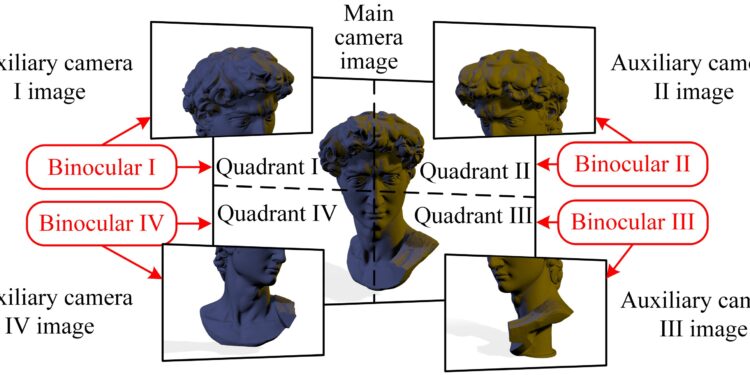Figure summarizing the principle of the sensor. Credit: Yang et al.
Recent technological advances have enabled the development of increasingly sophisticated sensors, which can help advance the sensing capabilities of robots, drones, autonomous vehicles and other intelligent systems. However, many of these sensors rely on individual cameras. The accuracy of the measurements they collect is therefore limited by the field of view (FOV) of the cameras.
Researchers at Beihang University in China recently developed a new multi-camera binocular differential vision sensor with a wider field of view that could collect more precise measurements. This sensor, presented in an article published in Optics and laser technologycould be integrated into a wide range of intelligent robotic devices and systems.
“Aiming at the high-precision requirements of environment perception for unmanned aerial vehicle detection, robot navigation and autonomous driving, inspired by the multi-camera module of mobile phones, we introduced a perception mode visual based on the principle of high precision binoculars. vision measurement,” Fuqiang Zhou, co-author of the paper, told Tech Xplore. “This principle involves a high-resolution central camera and peripheral auxiliary cameras that work together.”
The main goal of the recent study by Zhou and colleagues was to develop a sensor with a wider field of view. By using multiple cameras and placing them strategically, they set out to create a coordinated system that would collect more precise measurements than conventional single-camera-based sensors.
The structure behind the sensor design. Credit: Yang et al.
“Our multi-camera binocular differential vision sensor consists of a central main camera and four peripheral auxiliary cameras,” explained Zhou. “The images from the four quadrants of the main camera form four pairs of binoculars with the four images of the auxiliary camera. The sensor structure parameters are optimized from the point of view of spatial arrangement, measuring range and accuracy to collect high-precision three-dimensional measurements.”
Zhou and his colleagues tested the sensor they developed in a series of experiments and found that its field of view was significantly wider than that of conventional binocular cameras. By combining the field of view of multiple cameras, the sensor could collect more precise measurements of its surroundings.
“The proposed sensor has higher measurement accuracy than other visual measurement methods, especially compared to the same multi-camera measurement method, which reduces the number of cameras while improving measurement accuracy,” said Zhou said.
In the future, the sensor developed by this team of researchers could be integrated into a wide range of systems, including semi-autonomous or autonomous vehicles, robots and motion sensing devices. This will allow researchers to validate its performance in real-world contexts and further adapt their design to facilitate its future commercialization.
“In the field of vision measurement, binoculars are the best choice for high precision,” Zhou added. “Based on the proposed principle and idea, high-precision visual perception with large field of view is realized. With the combination of industrial small cameras and structure design to realize further miniaturization and light weight, this sensor could become a standard configuration similar to LiDAR in the future in unmanned intelligent systems.
More information:
Lemiao Yang et al, A new multi-camera differential binocular vision sensor, Optics and laser technology (2024). DOI: 10.1016/j.optlastec.2024.110624.
© 2024 Science X Network
Quote: A multi-camera differential binocular vision sensor for robots and autonomous systems (February 19, 2024) retrieved on February 19, 2024 from
This document is subject to copyright. Apart from fair use for private study or research purposes, no part may be reproduced without written permission. The content is provided for information only.



